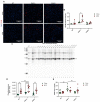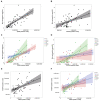Association of Differentially Altered Liver Fibrosis with Deposition of TGFBi in Stabilin-Deficient Mice
- PMID: 37446152
- PMCID: PMC10341388
- DOI: 10.3390/ijms241310969
Association of Differentially Altered Liver Fibrosis with Deposition of TGFBi in Stabilin-Deficient Mice
Abstract
Liver sinusoidal endothelial cells (LSECs) control clearance of Transforming growth factor, beta-induced, 68kDa (TGFBi) and Periostin (POSTN) through scavenger receptors Stabilin-1 (Stab1) and Stabilin-2 (Stab2). Stabilin inhibition can ameliorate atherosclerosis in mouse models, while Stabilin-double-knockout leads to glomerulofibrosis. Fibrotic organ damage may pose a limiting factor in future anti-Stabilin therapies. While Stab1-deficient (Stab1-/-) mice were shown to exhibit higher liver fibrosis levels upon challenges, fibrosis susceptibility has not been studied in Stab2-deficient (Stab2-/-) mice. Wildtype (WT), Stab1-/- and Stab2-/- mice were fed experimental diets, and local ligand abundance, hepatic fibrosis, and ligand plasma levels were measured. Hepatic fibrosis was increased in both Stab1-/- and Stab2-/- at baseline. A pro-fibrotic short Methionine-Choline-deficient (MCD) diet induced slightly increased liver fibrosis in Stab1-/- and Stab2-/- mice. A Choline-deficient L-amino acid-defined (CDAA) diet induced liver fibrosis of similar distribution and extent in all genotypes (WT, Stab1-/- and Stab2-/-). A hepatic abundance of Stabilin ligand TGFBi correlated very highly with liver fibrosis levels. In contrast, plasma levels of TGFBi were increased only in Stab2-/- mice after the CDAA diet but not the MCD diet, indicating the differential effects of these diets. Here we show that a single Stabilin deficiency of either Stab1 or Stab2 induces mildly increased collagen depositions under homeostatic conditions. Upon experimental dietary challenge, the local abundance of Stabilin ligand TGFBi was differentially altered in Stabilin-deficient mice, indicating differentially affected LSEC scavenger functions. Since anti-Stabilin-directed therapies are in clinical evaluation for the treatment of diseases, these findings bear relevance to treatment with novel anti-Stabilin agents.
Keywords: TGFBi; liver fibrosis; scavenger receptors.
Conflict of interest statement
The authors declare no conflict of interest.
Figures







References
-
- PrabhuDas M.R., Baldwin C.L., Bollyky P.L., Bowdish D.M.E., Drickamer K., Febbraio M., Herz J., Kobzik L., Krieger M., Loike J., et al. A Consensus Definitive Classification of Scavenger Receptors and Their Roles in Health and Disease. J. Immunol. 2017;198:3775–3789. doi: 10.4049/jimmunol.1700373. - DOI - PMC - PubMed
MeSH terms
Substances
Grants and funding
LinkOut - more resources
Full Text Sources
Medical
Molecular Biology Databases
Miscellaneous

